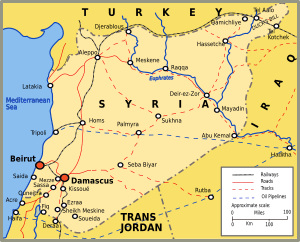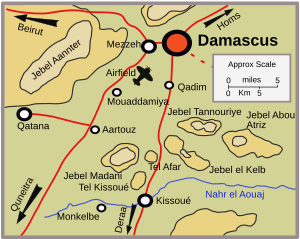Battle of Kissoué facts for kids
Quick facts for kids Battle of Kissoué |
|||||||
|---|---|---|---|---|---|---|---|
| Part of the Syria-Lebanon Campaign of World War II | |||||||
 Map of Syria and the Lebanon during World War II |
|||||||
|
|||||||
| Belligerents | |||||||
|
|
|
||||||
| Commanders and leaders | |||||||
The Battle of Kissoué was an important fight that happened on June 17, 1941. It was part of a bigger plan by the Allies to move into Damascus in Syria during World War II. This battle is special because it was a direct clash between two groups of French soldiers: the Vichy French and the Free French Forces. The Free French, who were fighting with the Allies, faced very strong opposition from the Vichy French.
Contents
Why Was the Battle of Kissoué Important?
This battle was a key part of the Syria-Lebanon campaign. The Allies wanted to take control of Syria and Lebanon. These areas were controlled by the Vichy French government, which was working with Nazi Germany. Taking Kissoué was important for the Allies to reach Damascus, the capital of Syria.
How Did the Battle Start?
On June 8, 1941, soldiers from the 5th Indian Infantry Brigade Group, led by Brigadier Wilfrid Lewis Lloyd, crossed into Syria. They came from Mandatory Palestine, which was controlled by Britain. Their goal was to capture the towns of Quneitra and Deraa. This would open the way for the Free French forces to advance towards Damascus.
This attack was one of four planned by the Allied commander, General Henry Maitland Wilson. By June 12, the Allied forces had captured Daraa, Sheikh Meskine, and Ezraa. These towns were on the road leading from Deraa to Damascus. The Indian and Free French forces, now called Gentforce, were then ready to attack Kissoué.
Who Led the Allied Forces?
French Major-General Paul Legentilhomme took command of Gentforce. However, he was injured almost immediately. On June 14, Brigadier Wilfrid Lewis Lloyd took over as the new commander.
What Made Kissoué a Stronghold?
Kissoué was a very strong place for defense.
- East of the main road, the town's gardens and houses offered good cover for soldiers and tanks.
- Behind the town were tall hills called Jebel el Kelb and Jebel Abou Atriz. These hills had strong defenses built into them.
- West of the road were more hills: Tel Kissoué, Tel Afar, and Jebel Madani. These hills overlooked the roads leading to Damascus from both Quneitra and Daraa.
- The land was very rocky, making it hard for vehicles to move off the main road. Even walking was difficult.
- A river called the Awaj flowed in front of the French positions, blocking the Allied advance.
The Battle: What Happened?
The main attack began at 4:00 AM on June 15. Indian troops launched a direct attack. By chance, this happened exactly when the Vichy French were changing their forward troops. After intense fighting, the village of Kissoué was captured by 8:30 AM.
By 9:00 AM, the Indian troops pushed into the hills behind the village. These hills overlooked the main road from the west. Within an hour, they had captured Tel Kissoué. On the far left side of the advance, Free French marines secured the village of Monkelbe by 11:30 AM.
The Second Phase of the Attack
A second part of the attack began at 11:00 AM. Free French forces crossed the river and advanced into the hills on the right side of the Damascus road. They captured Jebel Kelb. However, their advance stopped at Jebel Abou Atriz. On the far right, a flanking move by Free French tanks was halted by heavy shelling from Vichy French artillery.
Brigadier Lloyd received more bad news. Allied troops holding Quneitra reported that a strong Vichy French force was approaching from the north. Also, Lloyd's own supply lines were in danger. Vichy Tunisian troops had captured Ezraa, which was only about 6 miles (10 km) east of Sheikh Meskine. Sheikh Meskine was on the main road south from Kissoué.
Pushing Towards Damascus
Lloyd decided that a quick push to Damascus was the best way to handle the difficult situation. He sent two companies of Free French troops and some artillery south to Sheikh Meskine. This was to support the Transjordan Frontier Force, who had taken defensive positions there. Lloyd then ordered the Indian brigade to advance.
During the night of June 15, Indian troops moved through the hills to the left of the Kissoué to Damascus road. They captured Aartouz, which was on the Quneitra to Damascus road. This cut off the retreat path for the Vichy French force that was advancing on Quneitra.
On the afternoon of June 16, there was an incorrect report that Ezraa had been retaken by the Allies. The news from Quneitra was not good. The Allied defenders at Quneitra, a battalion of the Royal Fusiliers, were outnumbered three to one. They also faced tanks, which they couldn't fight effectively. They held out until 7:00 PM on June 16. Surrounded and almost out of ammunition, the remaining 13 officers and 164 men surrendered.
Despite this threat to Gentilforce's supply lines, the Allies decided to keep pushing towards Damascus. This forced the Vichy French commander to pull back his forces from the sides of the battle.


